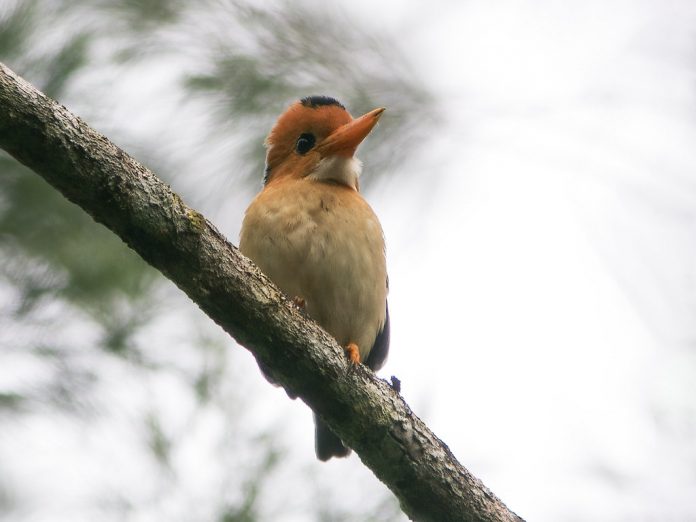Yellow-billed Kingfisher is a medium-size tree kingfisher. The tropical haunts of this least known of Australian kingfishers are so remote that few ornithologists have penetrated them for long enough to learn much of its behavior. What is known suggests that in its habits it resembles other small land kingfishers, such as the Sacred Kingfisher.

Yellow-billed Kingfisher habitat, however, is very different: the shady lower stages of rainforest and galleries of monsoon forest, particularly their drier ·edges abutting on eucalypt woodland. The bird is quiet, retiring-and usually solitary. Only during and immediately after breeding does it form loosely-knit pairs and small family parties, where ever it is found, probably numerous.
Yellow-billed Kingfisher diet include dragonflies, beetles, and other insects, as well as small lizards and earthworms. It hunts by perching motionless on a low, bare branch; when prey appears, it dives on it. Although the bird has been thought to be a sedentary breeder on the Cape York Peninsula, its numbers appear to fluctuate with the time of year.
This suggests local wandering rather than migration to New Guinea, judged by the fact that Australian Yellow-billed Kingfishers, which have distinctively pale grey-green backs, have never been found in New Guinea. Almost nothing has been recorded of the bird’s breeding habits and behavior, but it is known that neither sex defends the nest at all aggressively and may even desert it if disturbed.
It is also known as Lesser Yellow-billed Kingfisher, Saw-billed Kingfisher, or Lowland Yellow-billed Kingfisher. The size of the Yellow-billed Kingfisher is about 180–210 mm in length. The male head and neck are orange, with a thin black line around the front of the eyes and black spots on either side of the rear of the neck. Mantle and shoulders dusky grading into mid-green-grey; lower back and rump mid-turquoise-green.
However, the tail is dull cobalt blue above and dull grey below. The wings are rich olive-grey; flight feathers dusky black; underwing coverts are ochre-cream. The chin and throat are cream-graded into richer cinnamon buff on the breast and paler cream on the belly, flanks, and crissum. The eyes are dark brown and the bill is yellow to orange-yellow; with a dusky line on tip of the culmen.
The feets are cream and orange-yellow. The Female looks like a male but the top of the crown are black; the sides of the head are paler orange; black spots on the sides of the neck are larger, sometimes almost meeting at the back of the neck; however, the back and breast duller. The immature is pale and at least the females are black-headed like adult females; black in front of the eye extends behind the eye into a stripe. The cheeks, and sides of neck and breast flecked with black; upper bill extensively dusky black.
Yellow-billed Kingfisher call is loud, clear, usually descending trill of whistled notes, very like that of Fan-tailed Cuckoo but often more prolonged and sometimes rising and fading away at the end. Calling becomes animated and persistent throughout the day during breeding, but birds are rather silent at other times of year.
The nesting and breeding season is November–January, probably longer. Nest a burrow drilled into an arboreal termite mound or hollow limb in a tree, 3–18 m above ground. Burrows are 100–300 mm long, and enlarged at the end into the egg chamber. Eggs: three or four; smooth, glossy, pearly white; rounded, about 26 x 23 mm; laid on wood dust or termite rubble in the egg chamber.
The distribution of Yellow-billed Kingfisher is restricted to edges of rainforests and fringing tropical woodland, monsoon forest, and landward edges of mangroves on Cape York Peninsula south to Watson River and Princess Charloue Bay. One endemic race, with much washed-out blue-green back and persistent dusky wash on culmen. The other races are widespread in the lowlands of New Guinea and on offshore islands.







